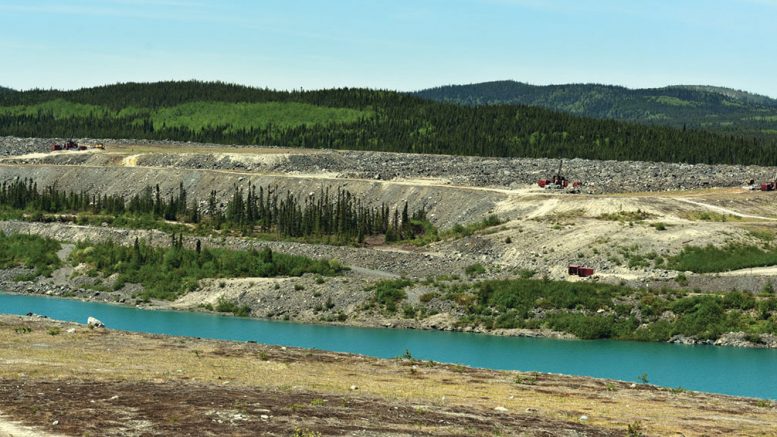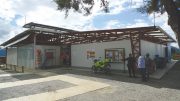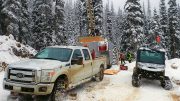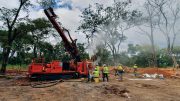Single-asset company Troilus Gold (TSX: TLG; US-OTC: CHXMF) has updated the resource estimate for its wholly owned Troilus gold project, 170 km north of Chibougamau, Quebec.
Indicated resources for the project stand at 159.1 million tonnes grading 0.78 gram gold per tonne, 0.09% copper and 1.19 grams silver per tonne for 3.97 million contained oz. gold, 301.15 million contained lb. copper and 6.07 million contained oz. silver.
Inferred resources add 52.7 million tonnes grading 0.9 gram gold per tonne, 0.08% copper and 1.01 grams silver for 1.53 million contained oz. gold, 94.89 million lb. copper and 1.71 million oz. silver.
The updated estimate, which represents a 20% increase in the indicated category from the 2018 resource estimate, is based on more than 36,000 metres of drilling in 81 holes, conducted from February to July. This is in addition to the 36,000 metres in 91 holes that the company drilled in August last year.
“We are now sitting on a 6.4 million oz. global resource that puts us as one of the largest developing gold assets in Quebec,” the company’s CEO Justin Reid says.
The updated resource estimate is based on two zones: Z87 and J (comprising J4 and J5). Mineralization at the Z87 zone is hosted in breccias and amphibolite-grade metamorphic rocks within a much broader, 4.5 km by 400-metre metamorphosed diorite known as the Troilus diorite. The mineral bodies in the J zone are hosted in the northern continuity of the Troilus diorite.

A drill rig at Troilus Gold’s namesake gold project near Chibougamau, Quebec. Credit: Troilus Gold.
“The J zone is open at depth, and we are finding some of our best grades and thicknesses approach the bottom of the pit, which is open to the northeast, and also in the shallow zone between the J zone and Z87,” Reid says.
The J4 pit has been mined to 150 metres’ depth, while the Z87 pit has been explored to a depth of 350 metres. “The orebody hadn’t really been tested at depth,” he adds.
The saddle zone between the Z87 and J zones also provide untested opportunities.
Blake Hylands, the company’s senior vice-president of exploration, says the latest drill results confirm that the mineralization at Troilus extends beyond the boundaries of the historic pits. The most significant contribution to the updated resource estimate comes from the J zone, where the pit-constrained potential has increased substantially and was “a key objective” of this year’s drill program.
The company embarked on a small drill program at the end of November. This seven-hole diamond-drill program covering 2,500 metres will test numerous expansion targets at Z86 South — an area 3.5 km south of the mine that had historically showed significant mineralization, with intercepts of 36 metres grading 1.23 grams gold and 18 metres of 1.06 grams gold.
A drilling program covering 20,000 metres to define existing resources on the main mine property is planned for 2020. “Next year is a huge year for us, both from the drilling and engineering side,” Reid says.
Hylands says he expects the results of the company’s 2020 program “will show additional growth potential of an already significant mineral resource estimate, and we will draw on our enhanced geological understanding to further explore the belt.”
Baseline studies for the environmental impact assessment of the project are nearing completion.
The company plans to complete a prefeasibility study in the second half of 2020. “Then we will be moving towards various production scenarios,” Reid says.
The company acquired the project in 2016 from First Quantum Minerals (TSX: FM).
First Quantum had bought the mine in 2013 from Inmet Mining, which operated an open-pit operation at Troilus from 1996 to 2009, producing more than 2 million oz. gold and nearly 70,000 tonnes copper.
“We got very lucky. We acquired what everybody considered to be an exhausted asset,” Reid says. “Our team approached it with new eyes and by putting a new geological model on it, we have quickly added an incredible amount of ounces, and we expect that it is going to continue.”
The Troilus property sits along the eastern segment of the Frotêt-Evans greenstone belt in Quebec’s Abitibi region. It is underlain by a sequence of intermediate to mafic flows and breccia locally with felsic volcanic rocks, and comagmatic gabbro and ultramafic sills.

A geology team looks over the historic Z87 pit at Troilus Gold’s namesake project in Quebec. Credit: Troilus Gold.
Exploration of the Troilus area started in 1958, after many erratic boulders containing copper and nickel anomalies were found.
Kerr Addison Mines staked two large blocks of claims that included the Troilus mine area in 1985 and 1987. Minnova entered into a fifty-fifty joint venture with Kerr Addison in 1988. Five years later, Metall Mining (which subsequently changed its name to Inmet Mining) acquired the property from both Minnova and Kerr Addison.
The company plans to operate a mine similar to the one that Inmet had run at Troilus. Reid says the plan, pending feasibility, is to start with an open-pit mining scenario and eventually supplement with a smaller, underground operation.
“We are not reinventing the wheel,” Reid says. “What sets us apart is that this is a brownfield site, so we are not starting from scratch.”
When Troilus picked up the project it already had 65 km of power lines, 45 km of access roads, a 50-megawatt substation, a permitted tailings facility, a water-treatment plant, and a 60-person exploration camp.
Reid says the existing infrastructure will lower the capex and shorten the time needed to get the required permitting for the project.
“We have a high degree of confidence that we can go right to the more advanced level of engineering,” he says, citing the project’s increased resources and the company’s understanding of the history and the costs of the past-producing mine.
The project’s location in mining-friendly Quebec is an advantage. “We couldn’t be in a better jurisdiction,” Reid says, noting Quebec’s long mining history and abundance of skilled labour. “The First Nations are very comfortable with our project [too], because Troilus as a past producer was a very large employer in the region.”
Richard Gray, an analyst with Cormark Securities, rates Troilus as a “buy” and has a 12-month target price of $2.90 per share, citing the increased resources and existing “excellent infrastructure” that should provide Troilus with significant cost savings and de-risk the development and permitting time line for the project.
The company is also remarkably undervalued, Gray says. “The project has the size and scope to garner significant re-rating as the company achieves further de-risking catalysts over the next 12 to 18 months, or become an attractive acquisition target for senior and mid-tier producers looking for large and undervalued resources in what is one of the safest jurisdictions in the world.”
Pierre Vaillancourt, an analyst with Haywood Securities, is also encouraged by the project’s robust resource, which adds mine life and improves the optionality of the deposit.
“However, we look for infill drilling and testing of new targets to improve the grade and depth of the resource, and ultimately, the economics of the project,” says Vaillancourt, who has a “buy” rating on the stock and a 12-month target price of $2.
At press time, Troilus was trading at 67¢ per share within a 52-week range of 49¢ to $1.16. The company has 69 million common shares outstanding for a $46-million market capitalization.






Be the first to comment on "Troilus Gold boosts resource in Quebec"